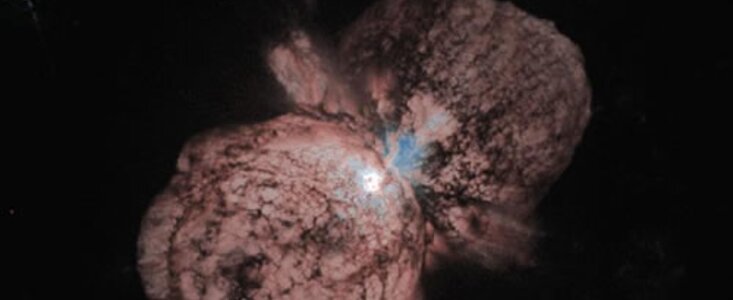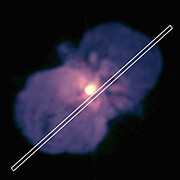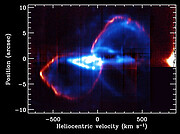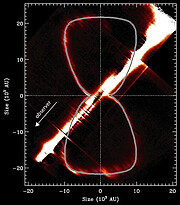Eta Carinae: A Spectacular Show From A Convulsing Massive Star
12 Abril 2006
Eta Carinae
The giant variable star Eta Carinae is one of the most remarkable stars in the southern sky. It lies just under 8,000 light-years away and, at about 100 times the mass of our Sun, is one of the most massive stars known. Eta Carinae is about five million times brighter than the Sun and is the brightest object outside of the solar system in the mid-infrared at 10-20 microns. It radiates most of its luminosity in the infrared part of the spectrum.
First catalogued by the English astronomer Edmond Halley in 1677, Eta Carinae's brightness has evolved dramatically throughout recent history. The most spectacular events took place during the nineteenth century, when it outshone all bright stars except Sirius. It underwent a great eruption in the mid-19th century and ejected many solar masses of gas and dust. We now observe this mass loss as a spectacular bipolar nebula called The Homunculus. Eta Carinae will probably end its life as a spectacular supernova in the next several thousand years.
Although the Homunculus Nebula around the massive star Eta Carinae has been the subject of intense study for many years, it has always been reluctant to divulge its innermost secrets. However, an important chapter in the recent evolution of this unique star was revealed when Nathan Smith (University of Colorado) used the high-resolution infrared spectrograph PHOENIX on the Gemini South telescope to observe the bipolar nebula surrounding Eta Carinae.
Multi-slit spectroscopy (see geminiann06009b) allowed Smith to reconstruct both the geometry and the velocity structure of the expanding gas in the nebula based on the behavior of the molecular line of hydrogen H2 at 2.1218 microns and the atomic line of ionized iron [Fe II] at 1.6435 microns (geminiann06009c).
Analysis of the PHOENIX spectrum shows a very well-defined shell structure expanding ballistically at about 500 kilometers per second (geminiann06009c). A “thick,” warm inner dust shell traced by [Fe II] emission is surrounded by a cooler and denser outer shell that is traced by strong H2 emission. Even though the outer H2 skin is remarkably thin and uniform it contains about 11 solar masses of gas and dust ejected over a period of less than five years. The Gemini spectra show that the density in the outer shell may reach 107 particles per cm3.
Analysis of the PHOENIX spectrum shows a very well-defined shell structure expanding ballistically at about 500 kilometers per second (geminiann06009c). A “thick,” warm inner dust shell traced by [Fe II] emission is surrounded by a cooler and denser outer shell that is traced by strong H2 emission. Even though the outer H2 skin is remarkably thin and uniform it contains about 11 solar masses of gas and dust ejected over a period of less than five years. The Gemini spectra show that the density in the outer shell may reach 107 particles per cm3.
The spatio-kinematic structure of H2 emission at the pinched waist of the nebula helps explain the unusual and complex structures seen in other high-resolution images. The current shape of the Homunculus nebula is of two well-defined polar lobes outlined by an outer massive shell of gas and dust (geminiann06009d). Smith states that these Gemini/PHOENIX data indicate that most of the mass lost during the Great Eruption of the mid-nineteenth century was limited to the high latitudes of the star, with almost all of the mechanical energy escaping between 45 degrees and the pole.
"The mass distribution in the nebula indicates that its shape is a direct result of an aspherical explosion from the star itself, instead of being pinched at the waist by the surrounding circumstellar material," said Smith.
Enlaces
- “The Structure of the Homunculus: I. Shape and Latitude Dependence from H2 and [Fe II] velocity Maps of Eta Carinae,” by Nathan Smith, The Astrophysical Journal





